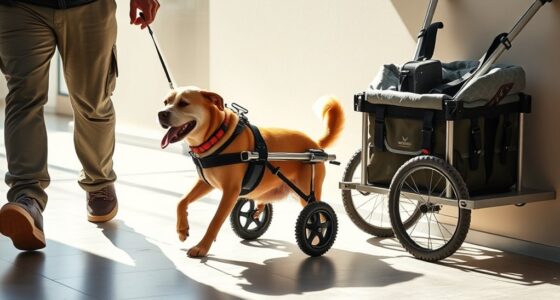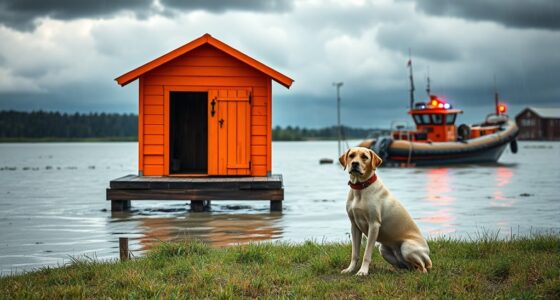During disasters, it’s vital to guarantee your pets have access to clean, safe water to prevent illness and dehydration. Stockpile at least a gallon per pet daily in food-grade, sealed containers stored in a cool, dark place. Use boiling, filtration, or purification tablets to treat natural water sources before giving them to your pets. Proper storage and early preparation are your best defenses—keep exploring to learn essential tips for keeping your pets healthy during emergencies.
Key Takeaways
- Stockpile at least one gallon of clean water per pet daily using food-grade, sealed containers stored in a cool, dark place.
- Regularly inspect and replace stored water to prevent bacterial growth and ensure freshness.
- Purify natural water sources with boiling, filtration, or water purification tablets before offering to pets.
- Avoid using contaminated water sources; always test or treat water from streams or ponds prior to use.
- Handle and store water carefully to prevent contamination, algae growth, and chemical leaching during emergencies.

During disasters, guaranteeing your pets have access to clean water becomes a critical priority, as their health depends on it just as much as yours. Water contamination can quickly become a serious issue when normal water sources are compromised, whether from flooding, storms, or infrastructure failures. Contaminated water may contain bacteria, chemicals, or debris that can cause illness in your pets, leading to dehydration, gastrointestinal problems, or worse. That’s why having a plan for emergency water supplies is essential. You need to be prepared to provide safe, uncontaminated water to your pets, even if local water systems are damaged or unsafe to drink from.
During disasters, ensure your pets have access to safe, uncontaminated water to protect their health and well-being.
To start, stockpile enough emergency water supplies for your pets to last several days. The general recommendation is at least one gallon of water per pet per day, but you should adjust this depending on their size, health, and specific needs. Store these supplies in clean, tightly sealed containers made of food-grade materials, and keep them in a cool, dark place to prevent spoilage or algae growth. When selecting containers, avoid those that can leach chemicals into the water or are prone to cracking. Remember, your goal is to provide your pets with safe water that’s free from water contamination, so regularly check your supplies for freshness and replace them as needed. Proper storage and handling of water supplies can help prevent the growth of harmful bacteria or algae.
In addition to stored water, it’s a good idea to have a method for purifying water from external sources during an emergency. Boiling water for at least one minute is one of the most reliable ways to kill bacteria and viruses, but you’ll need access to a heat source. Alternatively, water purification tablets or portable water filters designed to remove contaminants can be lifesavers. These tools are especially valuable if you need to source water from streams, ponds, or other natural sources. Always test or verify the effectiveness of your purification method to ensure it’s removing potential water contamination. Using water testing kits can help confirm the safety of your water sources before giving them to your pets.
During a disaster, never assume that running water from the tap is safe to give to your pets. If you suspect water contamination, avoid using it altogether unless you’ve properly purified it. Providing uncontaminated water helps prevent dehydration and keeps your pets healthy during stressful times. Remember, your pets rely on your preparedness to stay safe, so taking steps to secure clean water supplies before a disaster strikes is one of the most important things you can do. By planning ahead and knowing how to treat and store water, you’ll protect their health and wellbeing when they need you most. Additionally, being aware of water safety and contamination risks is crucial for maintaining their health during emergencies. Utilizing water purification methods such as portable filters and tablets can greatly reduce health risks associated with contaminated water sources.
Frequently Asked Questions
How Can I Identify Contaminated Water Sources for Pets?
To identify contaminated water sources for your pets, look for signs like strange odors, discoloration, or floating debris. Conduct water testing if possible, using simple kits to check for bacteria or chemicals. Be cautious of slimy surfaces or cloudy water, which indicate contamination. If you notice any signs or test results are suspicious, avoid using that water to keep your pets safe and healthy.
Are There Specific Water Purification Methods Safe for Pets?
You can use pet water filters designed specifically for animals to guarantee safe drinking water. These filters remove harmful bacteria, parasites, and chemicals effectively. Natural purification methods like boiling water for at least a minute can also work well for pets. Always choose safe, vet-approved filtration systems, and avoid using untreated water sources. Regularly maintain your filters to keep your pet’s water clean and healthy.
What Emergency Supplies Should I Stock for Pet Water Needs?
Imagine your pet’s tiny paws on a small bowl of fresh water, ready for pet hydration. You should stock emergency water storage with at least a three-day supply—bottled water or large, clean containers. Include a portable water filter or purification tablets for on-the-go needs. Don’t forget a collapsible bowl for easy feeding and water access, ensuring your furry friend stays hydrated and safe during any disaster.
How Often Should I Change Water During a Prolonged Disaster?
During a prolonged disaster, you should change your pet’s water regularly to maintain hydration and prevent bacterial growth. Stick to a consistent hydration schedule, ideally revitalizing water at least once daily, especially if stored in water storage containers. Keep an eye on the water’s clarity and smell, and refill as needed to ensure your pet always has access to clean, crisp water. Regular changes help keep your pet healthy and hydrated.
Can Pets Drink Bottled Water Safely During Emergencies?
You can safely give your pets bottled water for hydration during emergencies, but ensure it’s clean and properly sealed. Bottled water safety is generally reliable, making it a good option when tap water isn’t available or trusted. Always check the bottle’s expiration date and avoid water with unusual odor or color. Proper pet hydration is vital, so providing clean bottled water helps keep your pet healthy and hydrated during crises.
Conclusion
During disasters, ensuring your pets have access to clean water is vital for their health and safety. Imagine a homeowner who, after a flood, quickly sets up a simple water filtration system, preventing illness. By staying prepared and proactive, you protect your furry friends from waterborne dangers. Remember, a little planning can make all the difference—keeping your pets healthy and safe, no matter what emergencies come your way.










